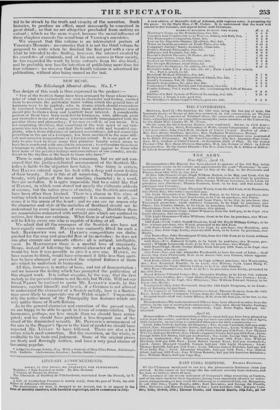NEW MUSIC.
The Edinburgh Musical Album. No. I. * THE design of this work is thus expressed in the preface:- " Few of the Scottish Songs have been arranged by those whose know- ledge of what was exclusively our own in character and feeling, enabled them to ascertain the particular limits within which the general laws of harmony were to be applied ; who, in strains which should everywhere he esteemed beautiful, could preserve those distinctive features which should give to them a deep and heartfelt• local interest. A considerable portion of them have been modelled by foreigners, who, although great and unrivalled in the art of song, were necessarily unacquainted with the peculiar idiom and phraseology, if we may so call it; of our music. It is not surprising, therefore, that something of the true spirit of our indi- genous airs has been lost ; and that their native wild and beautiful sim- plicity, which from difference of national associations, did not sound like perfection in the ear of a foreigner, has been sacrificed to the more diffi- cult and complex imaginations of a foreign school. It is one part of our
duty to give back to these songs that plaintive beauty which seems to have been cumbered with unsuitable ornament ; to retranslate them from a language in which; however beautiful they may appear to those who have none of the peculiar feelings and associations of our country, are de- ficient in the rhythm of the heart to those who have."
There is some plausibility in this reasoning, but we are not con- vinced that: the justly-celebrated arrangement of the Scottish Me- lodies is liable to the objection here taken. One thing is certain, that HAvnm entered upon his task with a deep and warm feeling of their beauty. Nor is this at all surprising. They abound with
beauty, with pathos of the most touching character ; in a word, they are melodies. It is quite impossible that to a mind like that of HAvnN, in which were stored not merely the elaborate addenda of science, but the native graces of melody, the Scottish airs could have been other than kindred. There is a charm in this class of
writing which is confined to no country : it is common to all, be- cause it is the music of the heart : and we can see no reason why
the character and style of the melodies of Scotland should not be understood by every musician of every country. Doubtless there are associations connected with national airs which are confined to natives, but these are extrinsic. What there is of intrinsic beauty,• will he felt by every one who is capable of feeling at all. We admit that all the arrangers of the Scottish airs have not been equally successful.'- HAYDN was eminently fitted for such a
task : BEETHOVEN was not. HAvDN's compositions are distin- guished for the easy and graceful flow of his melodies : he does not run after strange and uncouth effects: all is natural,
vocal. In BEETHOVEN there is a morbid love of singularity. Hence, inst,!ad of following the natural character of a melody, lie would try how it was possible to give it a new one. HAYDN, we have reason to think, would have esteemed it little less than sacri- lege to have changed or perverted the original features of those airs which he undertook to harmonize.
All this, however, is matter of taste, and not of demonstration ; and we honour the feeling which has prompted the publication of this elegant work. It is rather singular, by the way, that the first
melody in the present volume is not Scotch,but Welsh. Will not our friend PARRY be inclined to quote Mr. LINLEY'S words, in this instance, against himself; and to ask, if a German is not allowed to understand the character of a Scotch melody, how is a Scotch- man more likely to appreciate one of Welsh origin ? Unquestion- ably the native music of the Principality has features which are very unlike those of North Britain.
As to the general character and execution of the present work, we are happy to be able to speak in terms of commendation. The harmonies, perhaps, are less simple than we should have antici- pated; and we should have preferred a less frequent use of the chord of the diminished seventh. Dr. PEPUSCH'S arrangement of
the airs in the Beggar's Opera is the kind of model we should have expected Mr. LINLEY to have followed. There are also a few errors which need correction. But the execution, on the whole, is creditable to his taste and judgment. Some of the original pieces are freely and flowingly written, and have a very good chance of becoming popular.
* mated by George Linter, Esq. With a Portrait of 3liss Eliza Paton. Edinburgh.
1.329. Lothian. (Ackermann, London; Leckie, Dublin.)


















 Previous page
Previous page